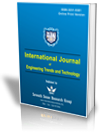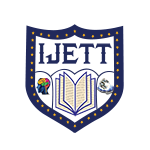Enhancing the Binary Soil Type Classification Performance with Augmented Data: An Eight-Layer Deep CNN and Pre-trained Models Investigation
Enhancing the Binary Soil Type Classification Performance with Augmented Data: An Eight-Layer Deep CNN and Pre-trained Models Investigation |
||
 |
 |
|
| © 2025 by IJETT Journal | ||
| Volume-73 Issue-4 |
||
| Year of Publication : 2025 | ||
| Author : G. Rubia, M. Nandhini |
||
| DOI : 10.14445/22315381/IJETT-V73I4P101 | ||
How to Cite?
G. Rubia, M. Nandhini, "Enhancing the Binary Soil Type Classification Performance with Augmented Data: An Eight-Layer Deep CNN and Pre-trained Models Investigation," International Journal of Engineering Trends and Technology, vol. 73, no. 4, pp. 1-16, 2025. Crossref, https://doi.org/10.14445/22315381/IJETT-V73I4P101
Abstract
The image classification is a subset of computer vision. It relies on Deep Learning (DL) techniques driven by artificial intelligence (AI) to efficiently identify and categorize images. The main aim of this paper is to develop a classification system that classifies soil types based on soil color. Soil-type classification systems are greatly needed to analyze soil data and provide relevant agriculture-related information. However, there are no cost-free methods to classify soil type. Therefore, this research work proposes soil type classification system using an Eight-Layer Deep Convolutional Neural Network (ELDCNN) and compares its performance with six pre-trained models such as densenet121, mobilenetv2, inceptionv3, resnet50, vgg19 and vgg16. Additionally, this work examines the impact of normalization and data augmentation as pre-processing techniques applied to both the ELDCNN model and six pre-trained models to determine their effect on classification performance. Initially, normalization is applied to the original soil images, and both models are evaluated, resulting in lower classification accuracy. To address this, data augmentation is applied to expand the original soil image dataset while preserving the existing data, resulting in higher classification accuracy. The ELDCNN model with data augmentation achieved a test accuracy of 95%. It is 8% better than the ELDCNN on original images with normalization. Similarly, after augmentation, densenet121 obtained 88% accuracy among all pre-trained models. This accuracy is 1% better than the testing accuracy achieved by densenet121 on original images with normalization applied. The results show that data augmentation significantly improves classification accuracy compared to normalization for both models. Determining the soil type is best performed with the proposed ELDCNN model due to its optimal testing accuracy obtained through augmentation techniques.
Keywords
Image Classification, Normalization, Data Augmentation, Eight-layer Deep Convolutional Neural Network, Pre-trained Models.
References
[1] Pallavi Srivastava, Aasheesh Shukla, and Atul Bansal, “A Comprehensive Review on Soil Classification Using Deep Learning and Computer Vision Techniques,” Multimedia Tools and Applications, vol. 80, pp. 14887-14914, 2021.
[CrossRef] [Google Scholar] [Publisher Link]
[2] M.C. Pegalajar et al., “A Munsell Colour-Based Approach for Soil Classification Using Fuzzy Logic and Artificial Neural Networks,” Fuzzy Sets and Systems, vol. 401, pp. 38-54, 2020.
[CrossRef] [Google Scholar] [Publisher Link]
[3] Pengcheng Han et al., “A Smartphone-Based Soil Color Sensor: For Soil Type Classification,” Computers and Electronics in Agriculture, vol. 123, pp. 232-241, 2016.
[CrossRef] [Google Scholar] [Publisher Link]
[4] Pramudyana Agus Harlianto, Teguh Bharata Adji, and Noor Akhmad Setiawan, “Comparison of Machine Learning Algorithms for Soil Type Classification,” 2017 3rd International Conference on Science and Technology - Computer, Yogyakarta, Indonesia, pp. 7-10, 2017.
[CrossRef] [Google Scholar] [Publisher Link]
[5] Priyanka Dewangan, and Vaibhav Dedhe, “Soil Classification Using Image Processing and Modified SVM Classifier,” International Journal of Trend in Scientific Research and Development, vol. 2, no. 6, pp. 504-507, 2018.
[CrossRef] [Google Scholar] [Publisher Link]
[6] Pappala Mohan Rao et al., “Investigating Efficiency of Soil Classification System Using Neural Network Models,” International Journal of Advanced Computer Science & Applications, vol. 14, no. 11, pp. 114-122, 2023.
[CrossRef] [Google Scholar] [Publisher Link]
[7] Mostafa Kiani Shahvandi, “Classification of Sentinel-2 Satellite Imagery in Iran for Geological Purposes Using Deep Convolutional Neural Networks: A Case Study for Soil Type Identification,” 2nd International Congress on Science and Engineering, Paris, 2020.
[Google Scholar] [Publisher Link]
[8] S.K. Al Zaminur Rahman, Kaushik Chandra Mitra, and S.M. Mohidul Islam, “Soil Classification Using Machine Learning Methods and Crop Suggestion Based on Soil Series,” 2018 21st International Conference of Computer and Information Technology, Dhaka, Bangladesh, pp. 1-4, 2018.
[CrossRef] [Google Scholar] [Publisher Link]
[9] Amol D. Vibhute et al., “Soil Type Classification and Mapping Using Hyperspectral Remote Sensing Data,” 2015 International Conference on Man and Machine Interfacing, Bhubaneswar, India, pp. 1-4, 2015.
[CrossRef] [Google Scholar] [Publisher Link]
[10] Shima Ramesh Maniyath et al., “Soil Color Detection Using Knn Classifier,” 2018 International Conference on Design Innovations for 3Cs Compute Communicate Control, Bangalore, India, pp. 52-55, 2018.
[CrossRef] [Google Scholar] [Publisher Link]
[11] Utpal Barman, and Ridip Dev Choudhury, “Soil Texture Classification Using Multi Class Support Vector Machine,” Information Processing in Agriculture, vol. 7, no. 2, pp. 318-332, 2020.
[CrossRef] [Google Scholar] [Publisher Link]
[12] P. Bhargavi, and S. Jyothi, “Soil Classification Using Data Mining Techniques: A Comparative Study,” International Journal of Engineering Trends and Technology, vol. 2, no. 1, pp. 55-59, 2011.
[Google Scholar][Publisher Link]
[13] Yuguo Qian et al., “Comparing Machine Learning Classifiers for Object-Based Land Cover Classification Using Very High-Resolution Imagery,” Remote Sensing, vol. 7, no. 1, pp. 153-168, 2015.
[CrossRef] [Google Scholar] [Publisher Link]
[14] T. Abimala, S. Flora Sashya, and K. Sripriya, “Soil Classification & Crop Suggestion Using Image Processing,” Easychair, no. 3544, pp. 1-8, 2020.
[Publisher Link]
[15] Abrham Debasu Mengistu, and Dagnachew Melesew Alemayehu, “Soil Characterization and Classification: A Hybrid Approach of Computer Vision and Sensor Network,” International Journal of Electrical & Computer Engineering, vol. 8, no. 2, pp. 989-995, 2018.
[CrossRef] [Google Scholar] [Publisher Link]
[16] N. Lakshmi Kalyani, and Kolla Bhanu Prakash, “Soil Color as a Measurement for Estimation of Fertility Using Deep Learning Techniques,” International Journal of Advanced Computer Science and Applications, vol. 13, no. 5, pp. 305-310, 2022.
[CrossRef] [Google Scholar] [Publisher Link]
[17] A. Balasubramanian, “Soils of India,” University of Mysore, pp. 1-43, 2017.
[Google Scholar]
[18] Ragunath Kaliaperumal et al., “Taxonomy of Tamilnadu Soils,” National Seminar on Soil Resilience, 2015.
[Publisher Link]
[19] Census of India 2011-Tamil Nadu-Series 34-Part XII A-District Census Handbook, Tiruppur, Central Data Catalog, India, 2014. [Online]. Available: https://new.census.gov.in/nada/index.php/catalog/1136
[20] Luis Perez, and Jason Wang, “The Effectiveness of Data Augmentation in Image Classification Using Deep Learning,” Arxiv, pp. 1-8, 2017.
[CrossRef] [Google Scholar] [Publisher Link]
[21] Alex Krizhevsky, Ilya Sutskever, and Geoffrey E. Hinton, “ImageNet Classification with Deep Convolutional Neural Networks,” Communications of the ACM, vol. 60, no. 6, pp. 84-90, 2017.
[CrossRef] [Google Scholar] [Publisher Link]
[22] Zdenek Kolar, Hainan Chen, and Xiaowei Luo, “Transfer Learning and Deep Convolutional Neural Networks for Safety Guardrail Detection in 2D Images,” Automation in Construction, vol. 89, pp. 58-70, 2018.
[CrossRef] [Google Scholar] [Publisher Link]
[23] Jia Shijie et al., “Research on Data Augmentation for Image Classification Based on Convolution Neural Networks,” 2017 Chinese Automation Congress, Jinan, China, pp. 4165-4170, 2017.
[CrossRef] [Google Scholar] [Publisher Link]
[24] Yann LeCun, Yoshua Bengio, and Geoffrey Hinton, “Deep Learning,” Nature, vol. 521, no. 7553, pp. 436-444, 2015.
[CrossRef] [Google Scholar] [Publisher Link]
[25] Xiangbin Liu et al., “A Review of Deep-Learning-Based Medical Image Segmentation Methods,” Sustainability, vol. 13, no. 3, pp. 1-29, 2021.
[CrossRef] [Google Scholar] [Publisher Link]
[26] Waseem Rawat, and Zenghui Wang, “Deep Convolutional Neural Networks for Image Classification: A Comprehensive Review,” Neural Computation, vol. 29, no. 9, pp. 2352-2449, 2017.
[CrossRef] [Google Scholar] [Publisher Link]
[27] D.H. Hubel, and T.N. Wiesel, “Receptive Fields, Binocular Interaction and Functional Architecture in the Cat’s Visual Cortex,” The Journal of Physiology, vol. 160, no. 1, pp. 106-154, 1962.
[CrossRef] [Google Scholar] [Publisher Link]
[28] Nadia Jmour, Sehla Zayen, and Afef Abdelkrim, “Convolutional Neural Networks for Image Classification,” International Conference on Advanced Systems and Electric Technologies, Hammamet, Tunisia, pp. 397-402, 2018.
[CrossRef] [Google Scholar] [Publisher Link]
[29] Gao Huang et al., “Densely Connected Convolutional Networks,” 2017 IEEE Conference on Computer Vision and Pattern Recognition, Honolulu, HI, USA, pp. 2261-2269, 2017.
[CrossRef] [Google Scholar] [Publisher Link]
[30] Debjyoti Sinha, and Mohamed El-Sharkawy, “Thin Mobilenet: An Enhanced Mobilenet Architecture,” 2019 IEEE 10th Annual Ubiquitous Computing, Electronics & Mobile Communication Conference, New York, NY, USA, pp. 280-285, 2019.
[CrossRef] [Google Scholar] [Publisher Link]
[31] Mark Sandler et al., “Mobilenetv2: Inverted Residuals and Linear Bottlenecks,” 2018 IEEE/CVF Conference on Computer Vision and Pattern Recognition, Salt Lake City, UT, USA, pp. 4510-4520, 2018.
[CrossRef] [Google Scholar] [Publisher Link]
[32] Christian Szegedy et al., “Rethinking the Inception Architecture for Computer Vision,” 2016 IEEE Conference on Computer Vision and Pattern Recognition, Las Vegas, NV, USA, pp. 2818-2826, 2016.
[CrossRef] [Google Scholar] [Publisher Link]
[33] Kaiming He et al., “Deep Residual Learning for Image Recognition,” 2016 IEEE Conference on Computer Vision and Pattern Recognition, Las Vegas, NV, USA, pp. 770-778, 2016.
[CrossRef] [Google Scholar] [Publisher Link]
[34] Karen Simonyan, and Andrew Zisserman, “Very Deep Convolutional Networks for Large-Scale Image Recognition,” Arxiv, pp. 1-14, 2014.
[CrossRef] [Google Scholar] [Publisher Link]
[35] Wahyudi Setiawan, and Fitri Damayanti, “Layers Modification of Convolutional Neural Network for Pneumonia Detection,” Journal of Physics: Conference Series, vol. 1477, no. 5, pp. 1-10, 2020.
[CrossRef] [Google Scholar] [Publisher Link]

